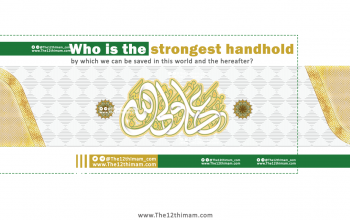Ḥadīth of Jābir (Arabic: حَدیث جابِر) is a hadith from Prophet Muhammad (s) to which the Shi’a appeal to demonstrate the imamate and specify their Imams (a). The hadith was transmitted by Jabir b. ‘Abd Allah al-Ansari. In this hadith, the Prophet (s) explicitly mentioned the Twelve Imams (a) of the Shi’a as well as the title of the Fifth Imam.
After the revelation of Uli l-Amr Verse [1] , Jabir b. ‘Abd Allah al-Ansari asked the Prophet (s): “O the messenger of God! We know God and His messenger; but we need to know the Uli l-Amr.” The Prophet (s) replied: “they are my successors and the imams of Muslims after me. The first is Ali b. Abi Talib (s), and then Hasan (s), Hussain (s), Ali b. al-Hussain (s), and Muhammad b. Ali (s) known in the Torah as “Baqir“, whom you will see at an old age, and whenever you see him, send my regards to him. After Muhammad b. Ali (s), Ja’far b. Muhammad (s), Musa b. Ja’far (s) , Ali b. Musa (s), Muhammad b. Ali (s) , Ali b. Muhammad (s) , Hasan b. Ali (s) , and then his son(twelfth imam) who is my namesake and has the same kunya [2] as mine. He is the one who will hide from people’s view, and his occultation will be so long that only people with firm beliefs will continue to believe in him”.[3]
The hadith was transmitted from the Prophet (s) by Jabir b. ‘Abd Allah al-Ansari. Thus, it came to be known as Hadith of Jabir. The Hadith of Jabir explicitly mentions the Twelve Imams of the Shi’a and their imamate. When the Prophet (s) mentions the Fifth Shiite Imam (a), he points to his title (“Baqir”), asking Jabir to send his regards to Imam al-Baqir (a). The hadith also points to the long Occultation of the Twelfth Imam of the Shi’a, analogizing the hidden Imam to the sun behind the clouds.[4]
The hadith was also cited in some Shiite sources, such as Kifayat al-athar,[5]Kamal al-din,[6] and Bihar al-anwar,[7] as well as some Sunni sources such as Yanabi’ al-mawadda.[8] Some Shiite exegetes of the Qur’an have cited the hadith under the discussion of the Uli l-Amr Verse.[9]
Reference:
[1] يَا أَيُّهَا الَّذِينَ آمَنُوا أَطِيعُوا اللَّـهَ وَأَطِيعُوا الرَّسُولَ وَأُولِي الْأَمْرِ مِنكُمْ
O you who have faith! Obey Allah and obey the Apostle and those vested with authority among you.
[2] Teknonym or Kunya (Arabic: كُنيَه) , in Arab culture, is used for those names which begin with prefix “Ab” (أب) or “Ibn” (إبن) for men and “Umm” (اُمّ) for women. They are generally followed by the oldest son’s name which means “father of” or “mother of” a person. Teknonym was mainly used as an honorific. However, it was also used for other reasons. Teknonym was regarded as a decent and respectful name or title in narrations, while a number of teknonyms were regarded disliked.
In Arabic culture, teknonym is a name other than the original name of the person which starts with “Ab” (Arabic: أب; meaning: father of) or “Umm” (Arabic: اُمّ; meaning: mother of) and it is used as an honorable and respectful name. However Bint (بنت; daughter of), Akh (أخ; brother of), Ukht (اُخت; sister of), Amm (عَمّ; uncle of), Ammat (عَمّة; aunt of), Khal (خال; uncle of) and Khalat (خالة; aunt of) are other kinds of teknonyms. Even sometimes teknonyms become more famous than names.
[3] Ṭabrisī, Iʿlām al-warā, vol. 2, p. 182; Qundūzī, Yanābīʿ al-mawadda, vol. 3, p. 398-399.
[4] Ṭabrisī, Iʿlām al-warā, vol. 2, p. 181-182.
[5] Khazzāz al-Rāzī, Kifāyat al-athar, p. 54-55.
[6] Ṣadūq, Kamāl al-dīn, vol. 1, p. 253-254.
[7] Majlisī, Biḥār al-anwār, vol. 36, p. 251.
[8] Qundūzī, Yanābīʿ al-mawadda, vol. 3, p. 398-399.
[9] Baḥrānī, al-Burhān, vol. 2, p. 103-104; Fayḍ al-Kāshānī, al-Aṣfā, vol. 1, p. 217.
- Baḥrānī, Sayyid Hāshim b. Sulaymān. Al-Burhān fī tafsīr al-Qurʾān. Qom: Bunyād-i Biʿthat, 1416 AH.
- Fayḍ al-Kāshānī, Muḥammad b. Murtaḍā. Al-Aṣfā fī tafsīr al-Qurʾān. Edited by Muḥammad Ḥusayn Dirāyatī & Muḥammad Riḍā Niʿmatī. Qom: Markaz-i Intishārāt-i Daftar-i Tablīghāt-i Islāmī, 1418 AH.
- Khazzāz al-Rāzī, ʿAlī b. Muḥammad al-. Kifāyat al-athar. Edited by Ḥusaynī Kuhkamarī. Qom: Bīdār, 1401 AH.
- Majlisī, Muḥammad Bāqir al-. Biḥār al-anwār. Second edition. Beirut: Dār Iḥyāʾ al-Turāth al-ʿArabī, 1403 AH.
- Qundūzī, Sulaymān b. Ibrāhīm al-. Yanābīʿ al-mawadda. Qom: Uswa, 1422 AH.
- Ṣadūq, Muḥammad b. ʿAlī al-. Kamāl al-dīn wa tamām al-niʿma. Edited by ʿAlī Akbar Ghaffārī. Tehran: Islāmīyya, 1395 Sh.
- Ṭabrisī, Faḍl b. al-Ḥasan al-. Iʿlām al-warā bi-aʿlām al-hudā. Qom: Āl al-Bayt, 1417 AH. (wikishia.net)
![The twelve imams who are the successors of the Prophet (s) [Ḥadīth of Jābir]](https://the12thimam.com/wp-content/uploads/2020/03/the-twelve-imams-who-are-the-successors-of-the-Prophet-s.png)


